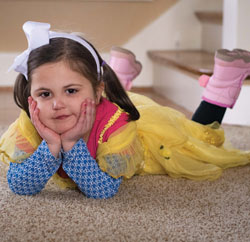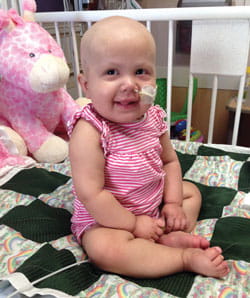When the Hospital Becomes Home
Cancer can take months, or even years, to treat. For families facing this heart-wrenching reality, we’re here to outsmart a relentless enemy and replace fear with hope.
There’s nothing more exciting than welcoming a new baby into the world. From gazing down over every little coo and smile to repeating over and over whatever brought on that first belly laugh, every day is special.
These were all things Ashlie and Brad were doing with their new daughter Hadley, when suddenly their world was shattered. All of that joy was replaced with fear and uncertainty. They began to wonder if their precious baby would even reach her first birthday.
“When she was about 6 months old, something didn’t feel quite right,” Ashlie remembers. “Hadley was suddenly off balance and having trouble sitting.”
Their pediatrician ordered a CT scan. When that came back fine, he thought Hadley may be fighting an ear infection and sent them home with an antibiotic. He told them if she didn’t seem better to bring her back.
Hadley wasn’t getting better — she was getting worse. Sick with worry, Ashlie and Brad brought her to their local hospital in Louisville for more tests. That’s when their world changed forever — Hadley had acute myeloid leukemia (AML).
After the initial shock wore off, Ashlie and Brad readied themselves to help their baby girl fight. Her doctors said Hadley’s best chance of beating this disease was a bone marrow transplant (BMT). Wanting the best care available for their daughter, the worried parents researched the best options and care programs.
That’s when they landed on Stella Davies, MD, and the Bone Marrow Transplant Program at Cincinnati Children’s.
“Everything I read told me that Dr. Davies would be the one to save Hadley,” Ashlie remembers. “We reached out, and were so thrilled that she agreed to see us.”
World-Renowned Cancer Care for the Whole Family
While AML is one of the most common types of cancers for adults over 40, it’s very rare for children, and it’s hard to find the specialized expertise kids need. That’s why families from all over the world turn to Cincinnati Children’s and Dr. Davies’ team for hope and healing.
Our BMT program is one of the largest — and busiest — in the nation. Many of the established protocols for care were developed right here by our experts. That’s one of the many reasons U.S. News & World Report ranked our cancer program No. 1 — and why more and more families are turning to us when they’re facing the unthinkable.
Our experts not only provide compassionate world-class care to our patients, but also their families, and we need our environment to reflect the caliber of our programs. Our new Critical Care Building (CCB) will not only be a state-of-the-art medical facility, but it will also offer family amenities that will help make a stressful and scary time a little easier to bear.
Home Is Where You Make It
The patients we treat in our bone marrow transplant unit can be with us for months, even years, at a time. The hospital becomes a second home, and it takes a toll not just on the patient, but on the entire family.
“Hadley was in the hospital for 222 days, and one of us was always with her,” Ashlie says, her voice growing softer. “And as grateful as we were for the care she was receiving, we missed our older daughters. We weren’t eating or sleeping well, and living in the hustle and bustle of a hospital wing was tough. Those were long, lonely, isolating days.”
With families like Hadley’s in mind, our new facility is designed to dramatically improve the family experience and allow us to make long stays at the medical center feel a little more like home.
With business centers to stay connected to the outside world, workout facilities to help ease stress, gardens to grab a few minutes of fresh air and family lounges to have space to connect with loved ones, the CCB will ensure that families have what they need to be the best they can be for their child.
“When Hadley was in the hospital, there really wasn’t any space for our older daughters to be,” says Ashlie. “The new family lounges sound fantastic. To be able to share a meal together and have a place to play with the girls — things that allow you to feel like a normal family for just a little bit — would have meant the world to us.”
Caring for the Care Team
Like our families, the clinicians who care for kids going through a transplant also need to be able to recharge. This is intense, challenging and draining work. That’s why the new building offers staff lounges, quiet respite spaces and outdoor gardens—all designed to engage and inspire our team members.
“Hadley’s doctors and nurses took this journey with us,” Ashlie remembers. “They celebrated with us, they cried with us — they were amazing. I can’t imagine what kind of toll it must take to go through this every single day with family after family.”
Back Where She Belongs
Eight months after Ashlie and Brad came to Cincinnati Children’s seeking hope for their daughter, she was cleared to go home. “Hadley was a tiny, sick little baby when she came to us,” Dr. Davies remembers with a smile. “But we quickly learned that Hadley is a warrior — she fought her way through everything she needed to do to get better.”
While Ashlie and Brad were relieved that their little girl was doing so well, they were a little hesitant about leaving the security of being surrounded by her care team. “Receiving the OK to go back to Louisville was bittersweet,” Brad shares. “We were thrilled, but scared at the same time. But we knew Dr. Davies was always just a phone call away.”
Today, Hadley is a spunky 5-year-old who loves school and playing with her friends. And her family is thankful every day for the care she continues to receive here. “We owe Hadley’s life to Cincinnati Children’s,” Ashlie says quietly. “We’d never take her anywhere else.”





